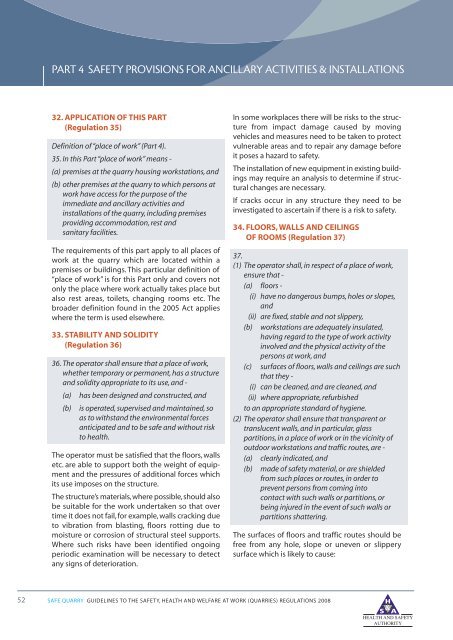Safe Quarry - Health and Safety Authority
Safe Quarry - Health and Safety Authority
Safe Quarry - Health and Safety Authority
Create successful ePaper yourself
Turn your PDF publications into a flip-book with our unique Google optimized e-Paper software.
PART 4 SAFETY PROVISIONS FOR ANCILLARY ACTIVITIES & INSTALLATIONS<br />
32. APPLICATION OF THIS PART<br />
(Regulation 35)<br />
Definition of “place of work” (Part 4).<br />
35. In this Part “place of work” means -<br />
(a) premises at the quarry housing workstations, <strong>and</strong><br />
(b) other premises at the quarry to which persons at<br />
work have access for the purpose of the<br />
immediate <strong>and</strong> ancillary activities <strong>and</strong><br />
installations of the quarry, including premises<br />
providing accommodation, rest <strong>and</strong><br />
sanitary facilities.<br />
The requirements of this part apply to all places of<br />
work at the quarry which are located within a<br />
premises or buildings. This particular definition of<br />
“place of work” is for this Part only <strong>and</strong> covers not<br />
only the place where work actually takes place but<br />
also rest areas, toilets, changing rooms etc. The<br />
broader definition found in the 2005 Act applies<br />
where the term is used elsewhere.<br />
33. STABILITY AND SOLIDITY<br />
(Regulation 36)<br />
36. The operator shall ensure that a place of work,<br />
whether temporary or permanent, has a structure<br />
<strong>and</strong> solidity appropriate to its use, <strong>and</strong> -<br />
(a) has been designed <strong>and</strong> constructed, <strong>and</strong><br />
(b) is operated, supervised <strong>and</strong> maintained, so<br />
as to withst<strong>and</strong> the environmental forces<br />
anticipated <strong>and</strong> to be safe <strong>and</strong> without risk<br />
to health.<br />
The operator must be satisfied that the floors, walls<br />
etc. are able to support both the weight of equipment<br />
<strong>and</strong> the pressures of additional forces which<br />
its use imposes on the structure.<br />
The structure’s materials,where possible,should also<br />
be suitable for the work undertaken so that over<br />
time it does not fail, for example, walls cracking due<br />
to vibration from blasting, floors rotting due to<br />
moisture or corrosion of structural steel supports.<br />
Where such risks have been identified ongoing<br />
periodic examination will be necessary to detect<br />
any signs of deterioration.<br />
In some workplaces there will be risks to the structure<br />
from impact damage caused by moving<br />
vehicles <strong>and</strong> measures need to be taken to protect<br />
vulnerable areas <strong>and</strong> to repair any damage before<br />
it poses a hazard to safety.<br />
The installation of new equipment in existing buildings<br />
may require an analysis to determine if structural<br />
changes are necessary.<br />
If cracks occur in any structure they need to be<br />
investigated to ascertain if there is a risk to safety.<br />
34. FLOORS, WALLS AND CEILINGS<br />
OF ROOMS (Regulation 37)<br />
37.<br />
(1) The operator shall, in respect of a place of work,<br />
ensure that -<br />
(a) floors -<br />
(i) have no dangerous bumps, holes or slopes,<br />
<strong>and</strong><br />
(ii) are fixed, stable <strong>and</strong> not slippery,<br />
(b) workstations are adequately insulated,<br />
having regard to the type of work activity<br />
involved <strong>and</strong> the physical activity of the<br />
persons at work, <strong>and</strong><br />
(c) surfaces of floors, walls <strong>and</strong> ceilings are such<br />
that they -<br />
(i) can be cleaned, <strong>and</strong> are cleaned, <strong>and</strong><br />
(ii) where appropriate, refurbished<br />
to an appropriate st<strong>and</strong>ard of hygiene.<br />
(2) The operator shall ensure that transparent or<br />
translucent walls, <strong>and</strong> in particular, glass<br />
partitions, in a place of work or in the vicinity of<br />
outdoor workstations <strong>and</strong> traffic routes, are -<br />
(a) clearly indicated, <strong>and</strong><br />
(b) made of safety material, or are shielded<br />
from such places or routes, in order to<br />
prevent persons from coming into<br />
contact with such walls or partitions, or<br />
being injured in the event of such walls or<br />
partitions shattering.<br />
The surfaces of floors <strong>and</strong> traffic routes should be<br />
free from any hole, slope or uneven or slippery<br />
surface which is likely to cause:<br />
52<br />
SAFE QUARRY GUIDELINES TO THE SAFETY, HEALTH AND WELFARE AT WORK (QUARRIES) REGULATIONS 2008
















